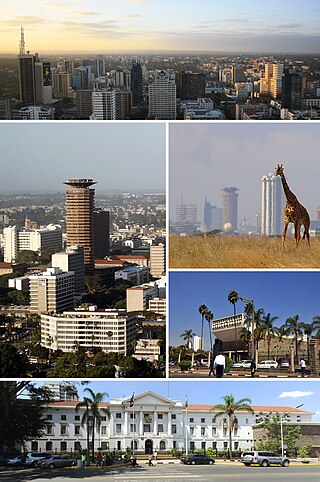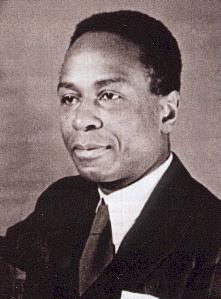
Nairobi is the capital and largest city of Kenya. The name is derived from the Maasai phrase Enkare Nairobi, which translates to 'place of cool waters', a reference to the Nairobi River which flows through the city. The city proper had a population of 4,397,073 in the 2019 census. The city is commonly referred to as 'The Green City in the Sun'.

Kofi Awoonor was a Ghanaian poet, author and diplomat. His work combined the poetic traditions of his native Ewe people with contemporary and religious symbolism to depict Africa during decolonization. He started writing under the name George Awoonor-Williams, and was also published as Kofi Nyidevu Awoonor. He taught African literature at the University of Ghana. Professor Awoonor was among those who were killed in the September 2013 attack at Westgate shopping mall in Nairobi, Kenya, where he was a participant at the Storymoja Hay Festival.

George Padmore, born Malcolm Ivan Meredith Nurse, was a leading Pan-Africanist, journalist, and author. He left his native Trinidad in 1924 to study medicine in the United States, where he also joined the Communist Party.

Komla Agbeli Gbedemah was a Ghanaian politician and Minister for Finance in Ghana's Nkrumah government between 1954 and 1961. Known popularly as "Afro Gbede", he was an indigene of Anyako in the Volta Region of Ghana.

The Makonde are an ethnic group in southeast Tanzania, northern Mozambique, and Kenya. The Makonde developed their culture on the Mueda Plateau in Mozambique. At present they live throughout Tanzania and Mozambique, and have a small presence in Kenya. The Makonde population in Tanzania was estimated in 2001 to be 1,140,000, and the 1997 census in Mozambique put the Makonde population in that country at 233,358, for an estimated total of 1,373,358. The ethnic group is roughly divided by the Ruvuma River; members of the group in Tanzania are referred to as the Makonde, and those in Mozambique as the Maconde. The two groups have developed separate languages over time but share a common origin and culture.

The Ewe people are a Gbe-speaking ethnic group. The largest population of Ewe people is in Ghana, and the second largest population is in Togo. They speak the Ewe language which belongs to the Gbe family of languages. They are related to other speakers of Gbe languages such as the Fon, Gen, Phla/Phera, Ogu/Gun, Maxi (Mahi), and the Aja people of Togo and Benin.

Wellerisms, named after sayings of Sam Weller in Charles Dickens's novel The Pickwick Papers, make fun of established clichés and proverbs by showing that they are wrong in certain situations, often when taken literally. In this sense, Wellerisms that include proverbs are a type of anti-proverb. Typically a Wellerism consists of three parts: a proverb or saying, a speaker, and an often humorously literal explanation.

Bethwell Allan Ogot is a Kenyan historian and eminent African scholar who specialises in African history, research methods and theory. One of his works starts by saying that "to tell the story of a past so as to portray an inevitable destiny is, for humankind, a need as universal as tool-making. To that extent, we may say that a human being is, by nature, historicus.

Embakasi is a neighbourhood in the city of Nairobi. It is approximately 18 kilometres (11 mi), southeast of the central business district. Embakasi is considered part of Nairobi's Eastlands area, lying to the south-east of Nairobi County. The Embakasi proper covers other estates in Eastlands such as Donholm, Pipeline, Tena, and Makadara estates. It borders South C and contains South B and slightly more than one third of Nairobi's Industrial Area and Export Processing Zones.
Togbe Ngoryifia Céphas Kosi Bansah, also known as Céphas Bansah, is the Ngoryifia of the Gbi Traditional area of Hohoe, Ghana.

Francis Kofi Ampenyin Allotey was a Ghanaian mathematical physicist. Together with Daniel Afedzi Akyeampong, he became the first Ghanaian to obtain a doctorate in mathematical sciences, earned in 1966.
Dudley Joseph Thompson was a Jamaican Pan-Africanist, lawyer, politician and diplomat, who made a contribution to jurisprudence and politics in the Caribbean, Africa and elsewhere internationally.
The name Makonde art refers to East African sculptures or, less frequently, to modern paintings created by craftspeople or artists belonging to the Makonde people of northern Mozambique and southern Tanzania, separated by the Ruvuma river. Art historians, dealers and collectors have created this genre of African art, that can be subdivided into African traditional artifacts or modern artistic works. This genre can be traced back to the 1930s, when the first documented exhibition of Makonde art was held at the Centro Cultural dos Novos in Mozambique.
Terry Hirst (1932–2015), was a British-Kenyan cartoonist and one of the leading figures in Africa's post-independence "golden age" of art and scholarship from the mid-1960s to the early 1980s which saw a flowering of work in the arts, cinema and the academic world. Terry Hirst was born in 1932 in Brighton in England. In 1965, Hirst moved to Kenya where he was to spend the rest of his life.

Ghana–Kenya relations are the bilateral relations between Ghana and Kenya. Ghana is a partner of Kenya in many areas, particularly trade, agriculture and energy. Both countries are members of the African Union, Group of 77, Commonwealth of Nations and Non-Aligned Movement.
Bank of India (Kenya) is a commercial bank in Kenya. It is one of the commercial banks licensed by the Central Bank of Kenya, the national banking regulator.
Dennis Akumu (1934-2016) was a Kenyan politician, trade unionist and independence freedom fighter. He was the first secretary general of the Organisation of African Trade Union Unity (OATUU).
The Nairobi People's Convention Party (NPCP) was a Nairobi based political party formed in 1957 by Tom Mboya. This party played a crucial role in the fight for Kenya's independence. Despite attempts at suppression from the colonial government, the NPCP managed to mobilise Africans in Nairobi to further the nationalist cause and fight for independence from Britain. Following Jomo Kenyatta's release from detention in 1961, the NPCP merged with the Kenya African Union (KAU) and Kenya Independence Movement (KIM) to form the Kenya African National Union (KANU).
Kodzo Afelete Ayeke was a Ghanaian politician, teacher, journalist, lawyer, and author. He was a member of parliament for Ho West, getting twice elected into parliament in 1954 and 1956 as a Togoland Congress member before joining the United Party on the ban of the Togoland Congress in 1958. As a journalist, he founded the Togoland Vanguard the first ever newspaper in the then Trans-Volta Togoland. An ethnic Ewe, he published two novels in the Ewe language, Asitsu Atoawo and Hlobiabia.













